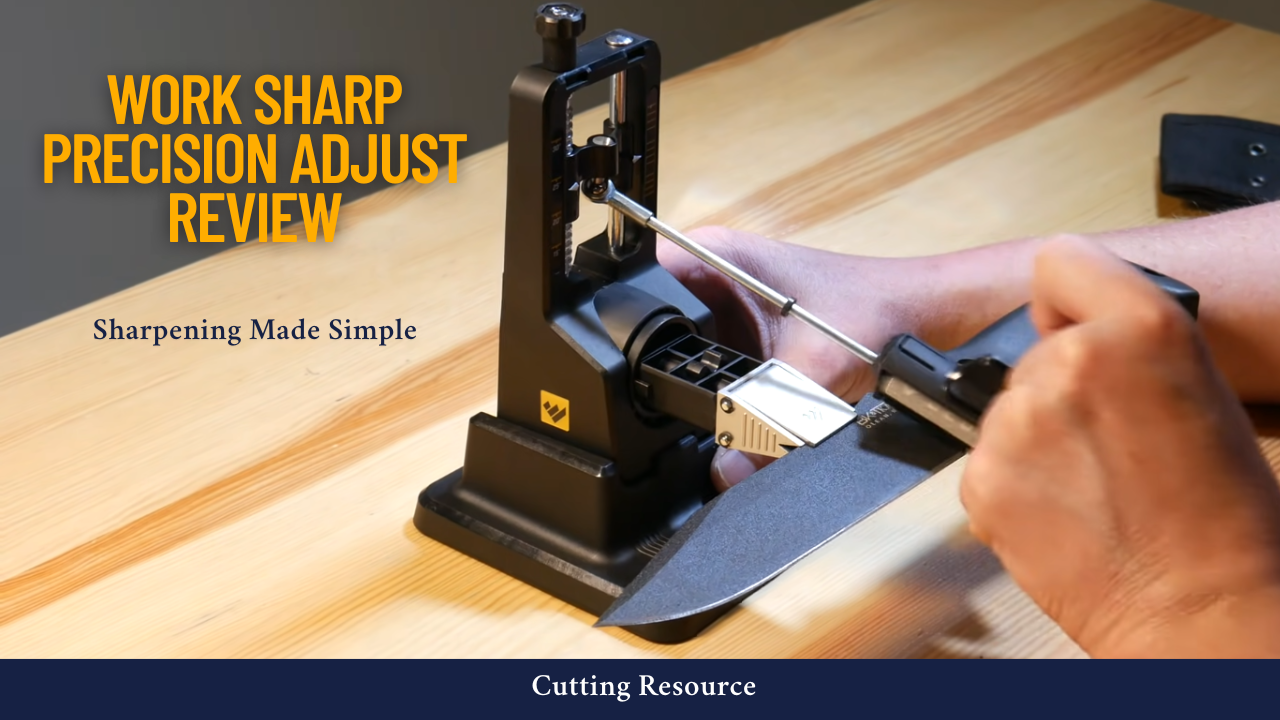There’s nothing more frustrating than trying to cook with a dull knife. It slows you down, crushes delicate ingredients, and frankly, just feels unsafe. Like many home cooks and pros alike, I’ve tested plenty of sharpeners over the years—some worked, many didn’t.
That’s why I was curious to try the Work Sharp Precision Adjust Knife Sharpener. I wanted something reliable, simple to use, and consistent. After weeks of testing it on everything from cheap paring knives to high-carbon Japanese blades, here’s what I found.
Overview of the Work Sharp Precision Adjust
The Work Sharp Precision Adjust is a manual knife sharpener with a guided system. It includes a rotating clamp to hold the knife securely and a 3-sided abrasive rod that you flip as you move through each sharpening stage. You can adjust the sharpening angle from 15 to 30 degrees using a dial. It’s one of the easiest systems for beginners to use, yet it gives pro-level results.
Who It’s For
This sharpener is a great fit for:
- Beginner cooks who want a foolproof method
- Knife collectors needing precise angles
- Professionals looking for consistent results
- Anyone sharpening multiple types of knives
If you’re tired of guessing angles or scraping blades on cheap pull-throughs, this is a worthy upgrade.
Setup and First Impressions
Ease of Setup
Setting it up takes just a few minutes. Out of the box, all you need to do is attach the clamp, insert the rod, and adjust your angle. No screws, no confusing parts. The user manual is simple and clear.
Design, Weight, and Build
It feels solid. The base is wide and rubberized for good grip. The clamp rotates smoothly and holds blades tightly. It’s not too heavy, but it stays put during sharpening.
Accessories Included
You get:
- Tri-Brasive rod with 320, 600 grit diamond plates and a ceramic finishing stone
- Rotating clamp
- Angle guide (15–30 degrees)
- Stable base with rubber feet
Sharpening Process: Step-by-Step
Three Stages Explained
- Coarse (320 grit) – Removes chips and shapes the edge
- Medium (600 grit) – Refines the edge
- Fine (ceramic) – Polishes and hones the blade
How It Works
- Clamp your knife.
- Set the desired angle.
- Slide the abrasive along the blade, using even strokes.
- Rotate the clamp to do the other side.
- Flip the rod to switch grits.
Each knife took me about 5–7 minutes, even very dull ones.
Precision Angle Setting
This is the best part. You dial in your angle between 15–30 degrees. It locks in place, and the consistency shows in the results.
Knife Compatibility and Performance
According to the American Knife & Tool Institute, the Precision Adjust system brings “rigidity, repeatability, and precision” to sharpening tasks, making it ideal for consistent edge maintenance across multiple knives.
Source: AKTI
Types of Knives It Works With
- Chef’s knives
- Paring knives
- Cleavers
- Japanese single-bevel (though tricky to clamp)
- Hunting and outdoor knives
Real Results
After sharpening, my $30 budget knife cleanly sliced through paper and tomatoes. My VG-10 Japanese chef’s knife? Razor-sharp.
Can It Convert Angles?
Yes. You can reshape a 20° edge to 15°, but it takes a bit longer.
Noise, Safety, and Maintenance
Noise Level
It’s very quiet. Just the sound of stone on metal. No motor.
Safety
Because the knife is clamped, it’s safer than freehand stones. The system guides your movement, reducing slip-ups.
Cleaning and Durability
A quick wipe is enough to clean. The abrasives are long-lasting. If needed, replacements are available. The warranty covers one year.
Comparison with Other Sharpeners
| Sharpener Model | Type | Pros | Cons | Best For |
| Work Sharp Precision Adjust | Manual | – Precise angle control- Easy for beginners- Stable base | – Slower than electric models- Clamp may not fit thick blades | Beginners, hobbyists, pros needing control |
| Chef’sChoice Trizor XV | Electric | – Fast sharpening- Great for Western-style knives | – Less control- Can be aggressive on delicate blades | Users wanting speed and convenience |
| Lansky Deluxe 5-Stone System | Manual | – Wide angle range- Effective on many knife types | – Time-consuming setup- Recalibration often needed | Budget-conscious tinkerers with patience |
| Traditional Whetstones | Manual | – Ultimate control- Excellent results with practice | – High learning curve- Takes longer | Experienced sharpeners, purists |
Pros and Cons
| Pros | Cons |
| Easy to set up and use | Clamp may struggle with thick blades |
| Precise angle adjustments | Takes longer than electric sharpeners |
| Excellent for various knife types | No storage case included |
| Affordable compared to pro setups | |
| Quiet and beginner-friendly |
Conclusion:Rating: 4.6/5
If you want a sharpener that combines control, precision, and ease-of-use, the Work Sharp Precision Adjust is hard to beat. Whether you’re sharpening a $10 beater knife or a $200 Japanese blade, it delivers.
It’s ideal for anyone who values sharp knives but doesn’t want to master whetstones. For the price, it punches far above its weight.
FAQs
Q1. Can the Work Sharp Precision Adjust sharpen serrated knives?
A: Not recommended. It’s best for straight edges. Serrated knives need a tapered rod or specialty sharpener.
Q2. How long does it take to sharpen a knife?
A: Around 5 to 7 minutes, depending on blade condition.
Q3. Is it good for beginners?
A: Yes. The guided system makes it very beginner-friendly.
Q4. Does it work on Japanese knives?
A: Yes, but single-bevel blades may need extra care when clamping.
Q5. Can I buy replacement abrasives?
A: Yes. Work Sharp sells replacement Tri-Brasive rods online.



